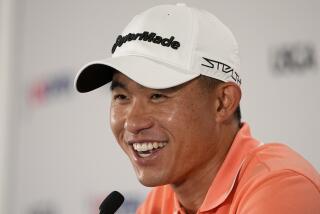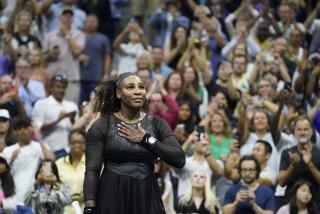TENNIS : Sampras Backs Out : U.S. Open loses some of its appeal and a potential glamour matchup when No. 1 player in world withdraws because of herniated disk.
- Share via
NEW YORK — The man in the green T-shirt and white Nike cap eased gingerly into the chair in front of the microphone, looking much like the last-place finisher in the Death Valley Marathon.
Pete Sampras, heavy beard matched by heavy eyelids, was there to say what was already known. He was there to make it official, to say the words that would make this U.S. Open tennis tournament less grand a slam. His words only served to confirm what the era of instant communication had, hours before, told a world of fans who so badly had wanted Sampras versus Agassi here Sept. 12.
He was hurt, out before his first match, done for the two weeks of the Open and off the tennis tour for at least a couple of months. The best player in the world, about to play his annual starring role on Broadway, had gone down in dress rehearsal, leaving the bright lights, sold-out house and curtain calls to Andre Agassi and a bunch of understudies.
Sampras injured his back Sunday afternoon, while practicing with Gustavo Kuerten of Brazil.
“It was on a return of serve,” Sampras recalled. “I didn’t hear anything, but I felt something go. I felt my back just go, you know, like it was stabbed by a knife. I immediately stopped.
“I was plenty warmed up. I hit for half an hour. I just started playing some points. You know, I went for this backhand return, and I felt it.
“It scared me. There’s no question it scared me. I just walked off the court.”
The diagnosis is a herniated disk, discovered after Sampras had suffered through a sleepless night Sunday followed by a Monday when he could barely move around his hotel room. Concerned doctors ordered a CT scan and an MRI.
Dr. Brian Hainline, medical director for the U.S. Tennis Assn., said the injury is at “what we call the L-5, S-1 level. It’s between the fifth lumbar vertebrae and the sacrum.” That means the lower back.
Hainline said that the disk tear is “very focal, right in the center,” and that it is not pressing on any nerves, so there is no loss of feeling in Sampras’ legs.
“If the disk ruptures and it starts going off to the side, it will then press on a nerve and then you have what is called sciatica, or pain radiating down the leg,” Hainline said.
This prompted at least three questions, all centered on one word, “damage.”
* What sort of damage had this done to Sampras’ career?
“With about a month of rest and rehabilitation, it should heal completely,” Hainline said.
Sampras had said earlier that no surgery would be needed, and Hainline agreed with that.
* What sort of damage had this done to Sampras’ mental state?
“I’m obviously overwhelmed, and I really wanted to have the chance to play here,” Sampras said. “I’m not saying I was going to win here or whatever, but, you know, to break the all-time record [12 Grand Slam event singles titles, set by Roy Emerson and tied by Sampras] was a dream I had, to do it here in New York.”
Sampras also said, “The last three days have been hell.”
* What sort of damage had this done to tennis, which had seemed, until recently, to be just dawdling along while golf became the darling of Madison Avenue?
Golf had its Tiger and tennis seemed to counter with Bohdan Ulihrach and five other guys from Europe with big forehands and clay-colored socks. That was, of course, when Sampras and Andre Agassi were not at the top of their games, or, worse, were not playing each other. And that was before Carlos Moya and Patrick Rafter, heartthrobs who could also play, got near the top of the rankings.
Then Agassi won the French Open, Sampras won Wimbledon and both had a tremendous summer of hard-court play that led them, and everybody who follows this sport closely, to drool at the prospect of a Sampras-Agassi final here. They were seeded 1 and 2, and when Agassi went through his first-round opponent in little more than an hour Monday night, the postmatch discussion was largely about the fairy-tale final.
Clearly, a field of excellent players remains. Clearly, the final, any U.S. Open final, will be special, competitive. But the fall in the public perception of Sampras-Agassi to anything else is a long one.
“This is tough for so many people, the fans, myself and ultimately Pete,” said Agassi, who called Sampras at his hotel Tuesday morning when he heard the news. “I was really sorry about it. Sorry for him, sorry for tennis.
“[A Sampras-Agassi final] would have been an awesome time.”
For tennis fans, the silver lining in all this is that the fire burns hot in Sampras to make it back, as soon as possible.
His coach, former tour player Paul Annacone, said Sampras, who turned 28 on Aug. 12, told him, after learning of the severity of the injury, that he still had “20-25 Grand Slams left in him.”
It remains fashionable to misread Sampras’ fire, and that made it a fairly prevalent hypothesis in the aftermath of his departure that this could be the end. Even when he said, “There’s no question. I’ll be back here,” there were some knowing looks.
No less an expert than Stan Smith, former Wimbledon and U.S. Open champion, who coached Sampras for a short time early in his career, once misread him.
“It was one of his early Wimbledons and he lost early,” Smith recalled. “I went into the locker room and said something to him to try and console him and he didn’t seem to care all that much. I remember thinking that he would never make it. I totally misread the fire that was there.”
Last year, a month or so after the U.S. Open, when Sampras had lost in five sets to eventual champion Rafter after hurting his leg in the fourth set, Sampras talked about that semifinal match.
What would he have done, he was asked, if he had been able to hobble through to the end and beat Rafter? Would he have been too injured to play the final?
“I would have gotten a shot, whatever they could give me,” he said. “It was the U.S. Open.”
Take that as a hint. The man who, with some help from Agassi, has carried the men’s side of this sport on his back for years now, is temporarily having a little trouble with the heavy lifting. But come 2000 here, he’ll be eager to clean and jerk.
(BEGIN TEXT OF INFOBOX / INFOGRAPHIC)
Sampras Out of the Open
Top-seeded Pete Sampras pulled out of the U.S. Open because of a herniated disk in his back. The injury delayed his bid to overtake Roy Emerson for the most Grand slam singles titles in history.
*
Sampras suffered a small tear in the disk between the L% and S1 sacral vertebrae.
Treatment
1. Rest, recovery takes 4-8 weeks
2. Well-structured rehabilitation (aqua therapy in pool)
*
Sources: Grant’s Atlas pf anatomy; Dr. Vijay Vad, The Hospital for Special Surgery
More to Read
Go beyond the scoreboard
Get the latest on L.A.'s teams in the daily Sports Report newsletter.
You may occasionally receive promotional content from the Los Angeles Times.











